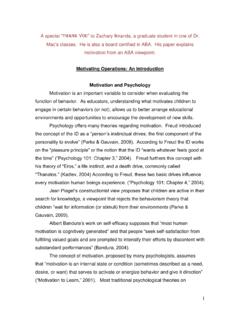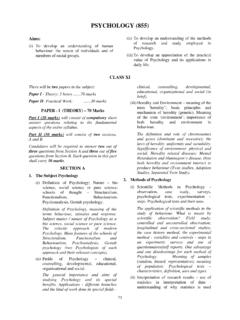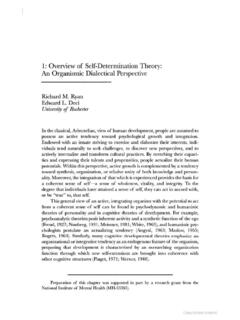Transcription of Motivation - Purdue
1 1 1 Motivation Chapter 11 2 What Motivates You To Come To Class? 3 Motivation Motivation is a need or desire that energizes behavior and directs it towards a goal. What s the difference between a need and a desire? Extrinsic Motivation is something outside the person that energizes behavior. Money, fame, power Intrinsic Motivation is something within the person that energizes behavior. Interest, curiosity, personal challenge and improvement 4 Do Rats Have a Protestant Work Ethic? The earned vs. free food phenomenon 5 Perspectives on Motivation Perspectives to explain Motivation include the following: Instinct Theory Drive-Reduction Theory Arousal Theory Hierarchy of Motives Cognitive based theory: Self-efficacy 6 Instincts & Evolutionary Psychology Instincts are complex behaviors that have fixed patterns throughout different species and are not learned (Tinbergen, 1951). Where the woman builds different kinds of houses the bird builds only one kind of nest.
2 Ariel Skelley/ Masterfile Tony Brandenburg/ Bruce Coleman, Inc. 2 7 Drive-Reduction Theory When the instinct theory of Motivation failed to explain most human Motivation , it was replaced by the drive-reduction theory. A physiological need creates an aroused tension state (a drive) that motivates an organism to satisfy the need (Hull, 1951). 8 Drive Reduction Food Drive Reduction Organism The physiological aim of drive reduction is homeostasis, the maintenance of a steady internal state ( , maintenance of steady body temperature). Stomach Full Empty Stomach (Food Deprived) 9 Incentive Where our needs push, incentives (positive or negative stimuli) pull us in reducing our drives. Henry Murray called these needs and presses. A food-deprived person (n Hunger) who smells baking bread (incentive) (p Food) feels a strong hunger drive. 10 Question What need would explain why we seek thrills, excitement? Why do we like scary movies?
3 What drives are being reduced by going on a roller coaster or parachuting? 11 Optimum Arousal Human Motivation aims to seek optimum levels of arousal, not to eliminate it. Young monkeys and children are known to explore the environment in the absence of a need-based drive. Harlow Primate Laboratory, University of Wisconsin Randy Faris/ Corbis 12 Hierarchy of Needs Abraham Maslow (1970) suggested that certain needs have priority over others. Physiological needs like breathing, thirst, and hunger come before psychological needs such as achievement, self-esteem, and the need for recognition. (1908-1970) 3 13 Maslow s Hierarchy of Needs Hurricane Survivors Menahem Kahana/ AFP/ Getty Images Mario Tama/ Getty Images David Portnoy/ Getty Images for Stern Joe Skipper/ Reuters/ Corbis 14 Self-Efficacy- bandura A belief (cognitive component of theory) in one s abilities to succeed A sense of control over one s environment (social, work, etc.)
4 Self-efficacy can be strengthened with clear goals, social modeling, feedback, and challenges to current ability levels. On YouTube, there are many short videos about self-efficacy. 15 Classic Positions on Motivation Freud Id Ego Superego Skinner Reinforcement Humanistic (Maslow, Rogers) Self-actualization Specific Motivations Social Control Hunger Sex Belonging Work 16 17 Social Motivation Others opinions and evaluations of self contribute to a strong motivating system Social Facilitation, Social Loafing Self-monitoring Fame Being known, recognized may supersede being liked Jerry Springer s guests? Conformity Fitting in = Being liked Avoiding rejection/exclusion Social Motivation contributes to what and how much we eat, whether or not we smoke, take drugs, have 18 Coactive or Evaluative Presence of Others likelihood of dominant response performance on easy, well-learned tasks performance on difficult, poorly learned tasks But, why?
5 (1) Compresence (Zajonc, 1966) (2) Evaluation apprehension (Cottrell, 1968) (3) Distraction-conflict (Baron & Sanders, 1986) Arousal 4 19 20 Latan , Williams, & Harkins (1979) 21 Control Motivation Reactance When you feel that your freedom is being restricted, you will act in such a way to regain that freedom Learned Helplessness Upon repeated noncontingencies between one s behaviors and one s outcomes (and after initial reactance), learned helplessness occurs Uncontrolled negative outcomes more likely to cause LH than uncontrolled positive outcomes But see Self-handicapping Giving up Pessimism Depression Learned Helplessness Tutorial 22 Hunger When do we eat? Why do we like certain foods and not others? Why do we eat too much? Why do our emotions affect our eating? An obvious answer to When do we eat? is When are we hungry. Turns out, that s only part of the answer. But, how do we know when we are hungry?
6 When there is no food in our stomach. How do we know when our stomach is empty? Our stomach growls. These are also called hunger pangs. 23 The Physiology of Hunger Stomach contractions (pangs) send signals to the brain making us aware of our hunger. 24 Removed Tsang (1938) removed rat stomachs, connected the esophagus to the small intestines, and the rats still felt hungry (and ate food). In other words, no hunger pangs were eating persisted 5 25 The Importance of Glucose: C6H12O6 Increases in insulin (a hormone affecting pancreas, liver, muscle, and fat tissue) decreases glucose in the blood. Decreased glucose makes us feel hungry. Glucose Molecule Insulin also affects brain: improves verbal memory 26 Glucose & the Brain Levels of glucose in the blood are monitored by receptors (neurons) in the stomach, liver, and intestines. They send signals to the hypothalamus in the brain. Rat Hypothalamus 27 Hypothalamic Centers The lateral hypothalamus (LH) brings on hunger (stimulation).
7 Destroy the LH, and the animal has no interest in eating. With the LH intact, the reduction of blood glucose leads rats to eat ravenously. 28 Hypothalamic Centers The ventromedial hypothalamus (VMH) depresses hunger (when stimulated). If you destroy the VMH, the animal eats excessively. 29 Hypothalamus & Hormones The hypothalamus monitors a number of hormones that are related to hunger. Hormone Tissue Response Orexin increase Hypothalamus Increases hunger Ghrelin increase Stomach Increases hunger Insulin increase Pancreas Increases hunger Leptin increase Fat cells Decreases hunger PPY increase Digestive tract Decreases hunger 30 Set-Point Theory Manipulating the lateral and the ventromedial hypothalamus alters the body s weight thermostat. If weight is lost, food intake increases and energy expenditure decreases. If weight is gained, the opposite takes place. 6 31 The Psychology of Hunger Memory plays an important role in hunger.
8 When did I eat last? Due to difficulties with retention, amnesia patients eat frequently if given food (Rozin et al., 1998). Schachter found that manipulating a clock on the wall influenced reports of hunger, and willingness to eat. Social Factors We eat when others eat whether we are hungry or not; we tend not to like eating alone (especially females) Females eat less with a male than they eat with a female. (Males are unaffected) Current investigation here at Purdue examining whether fat rats will regulate their intake when in the presence of skinny rats. 32 33 Taste Preference: Biology or Culture? Body chemistry and environmental factors influence not only when we feel hunger but what we feel hungry for! Fullness doesn t necessarily mean you don t want to eat anything else. It often means, I am tired of that particular taste. Richard Olsenius/ Black Star Victor Englebert 34 Hot Cultures like Hot Spices Countries with hot climates use more bacteria-inhibiting spices in meat dishes.
9 35 Eating Disorders Anorexia Nervosa: A condition in which a normal-weight person (usually an adolescent woman) continuously loses weight but still feels overweight. Reprinted by permission of The New England Journal of Medicine, 207, (Oct 5, 1932), 613-617. Lisa O Connor/ Zuma/ Corbis 36 Is the Relationship between Eating and Weight Gain That Simple? 7 37 Eating Disorders Bulimia Nervosa: A disorder characterized by episodes of overeating, usually high-calorie foods, followed by vomiting, using laxatives, fasting, or excessive exercise. 38 Obesity A disorder characterized by being excessively overweight. Obesity increases the risk for health issues like cardiovascular diseases, diabetes, hypertension, arthritis, and back problems. 39 Reasons for Eating Disorders Sexual Abuse Myth: Childhood sexual abuse does not cause eating disorders. Family: Younger generations develop eating disorders when raised in families in which weight is an excessive concern.
10 Genetics: Twin studies show that eating disorders are more likely to occur in identical twins rather than fraternal twins. Social: Advertising/peer pressure/norms. 40 Body Image (Women) Western culture tends to place more emphasis on a thin body image in comparison to other cultures. 41 Summary Sexual Motivation 42 8 43 Sexual Motivation Why are we sexually attracted to certain others? What, specifically, is motivating about sex? Sexual Motivation is nature s clever way of making people procreate, enabling our species to survive. Waist-to-hip ratio Interestingly, despite variations in cultures and eras for women s weight, men have always preferred women as mates who have roughly the same waist-to-hip ratio. The ideal ratio for women is considered to be about Devendra Singh s (1993) research 44 45 The Physiology of Sex Masters and Johnson (1966) describe the human sexual response to consist of four phases: Phase Physiological Response Excitement Genitals become engorged with blood.





